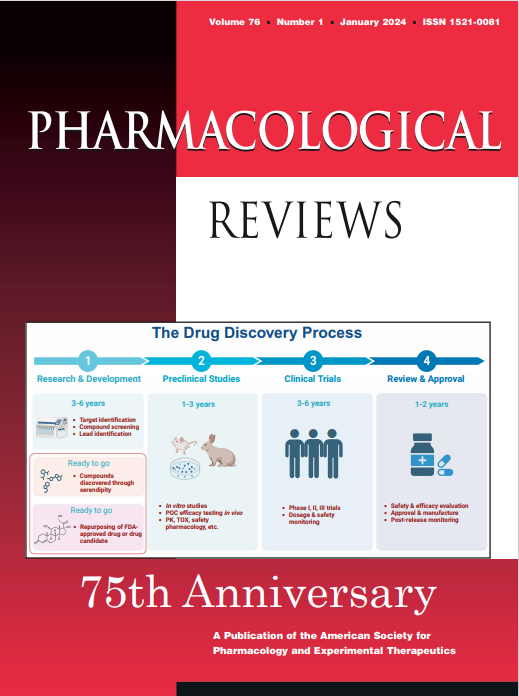The 75-Year Anniversary of the Department of Physiology and Pharmacology at Karolinska Institutet—Examples of Recent Accomplishments and Future Perspectives
IF 17.3
1区 医学
Q1 PHARMACOLOGY & PHARMACY
引用次数: 0
Abstract
Karolinska Institutet is a medical university encompassing 21 departments distributed across three departmental or campus groups. Pharmacological research has a long and successful tradition at the institute with a multitude of seminal findings in the areas of neuronal control of vasodilatation, cardiovascular pharmacology, neuropsychopharmacology, receptor pharmacology, and pharmacogenomics that resulted in, among many other recognitions, two Nobel prizes in Physiology and Medicine, one in 1970 to Ulf von Euler for his discovery of the processes involved in storage, release, and inactivation of neurotransmitters and the other in 1982 to Sune Bergström and Bengt Samuelsson for their work on prostaglandins and the discovery of leukotrienes. Pharmacology at Karolinska Institutet has over the last decade been ranked globally among the top 10 according to the QS World University Ranking. With the Department of Physiology and Pharmacology now celebrating its 75-year anniversary, we wanted to take this as an opportunity to showcase recent research achievements and how they paved the way for current activities at the department. We emphasize examples from preclinical and clinical research where the dpartment's integrative environment and robust infrastructure have successfully facilitated the translation of findings into clinical applications and patient benefits. The close collaboration between preclinical scientists and clinical researchers across various disciplines, along with a strong network of partnerships within the department and beyond, positions us to continue leading world-class pharmacological research at the Department of Physiology and Pharmacology for decades to come.卡罗林斯卡医学院生理学和药理学系 75 周年纪念--近期成就实例与未来展望
卡罗林斯卡医学院是一所医科大学,下设 21 个系,分布在三个部门或校园集团。卡罗林斯卡医学院在药理学研究方面有着悠久而成功的传统,在神经元控制血管扩张、心血管药理学、神经精神药理学、受体药理学和药物基因组学等领域取得了许多开创性的研究成果,并获得了许多其他认可、1970 年,乌尔夫-冯-欧拉(Ulf von Euler)因发现神经递质的储存、释放和失活过程而荣获诺贝尔生理学与医学奖;1982 年,苏内-伯格斯特罗姆(Sune Bergström)和本特-萨缪尔森(Bengt Samuelsson)因研究前列腺素和发现白三烯而荣获诺贝尔生理学与医学奖。根据 QS 世界大学排名,卡罗林斯卡医学院的药理学在过去十年中一直位居全球前十名。在生理学和药理学系迎来 75 周年庆典之际,我们希望借此机会展示最近的研究成果,以及这些成果如何为该系当前的活动铺平了道路。我们强调临床前和临床研究中的实例,在这些实例中,生理学与药理学系的综合环境和强大的基础设施成功地促进了研究成果转化为临床应用并造福患者。临床前科学家和各学科临床研究人员之间的密切合作,以及系内外强大的合作伙伴网络,使我们能够在未来数十年中继续引领生理学和药理学系的世界级药理学研究。
本文章由计算机程序翻译,如有差异,请以英文原文为准。
求助全文
约1分钟内获得全文
求助全文
来源期刊

Pharmacological Reviews
医学-药学
CiteScore
34.70
自引率
0.50%
发文量
40
期刊介绍:
Pharmacological Reviews is a highly popular and well-received journal that has a long and rich history of success. It was first published in 1949 and is currently published bimonthly online by the American Society for Pharmacology and Experimental Therapeutics. The journal is indexed or abstracted by various databases, including Biological Abstracts, BIOSIS Previews Database, Biosciences Information Service, Current Contents/Life Sciences, EMBASE/Excerpta Medica, Index Medicus, Index to Scientific Reviews, Medical Documentation Service, Reference Update, Research Alerts, Science Citation Index, and SciSearch. Pharmacological Reviews offers comprehensive reviews of new pharmacological fields and is able to stay up-to-date with published content. Overall, it is highly regarded by scholars.
 求助内容:
求助内容: 应助结果提醒方式:
应助结果提醒方式:


